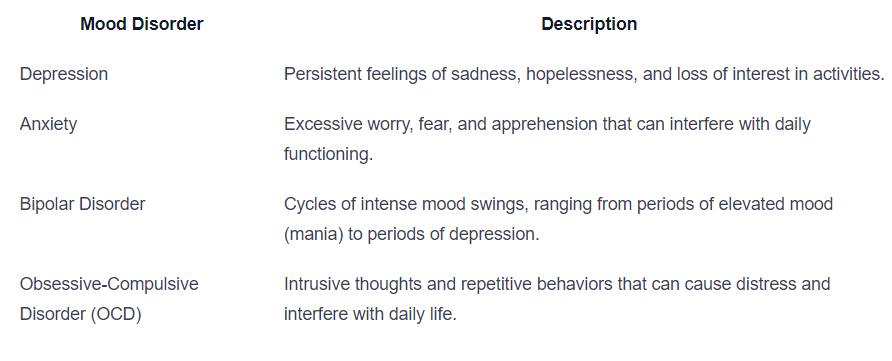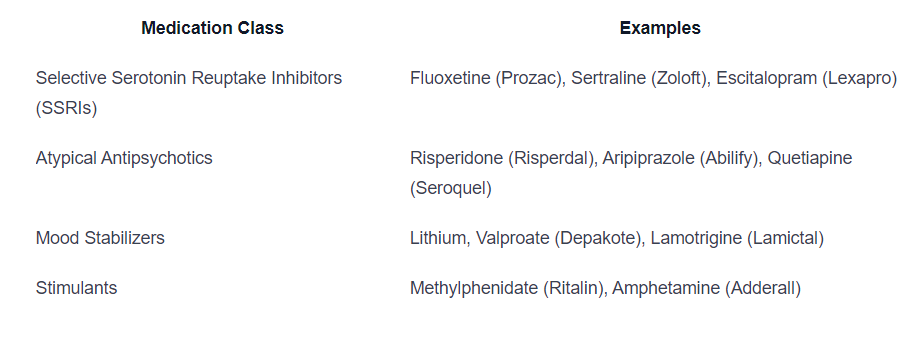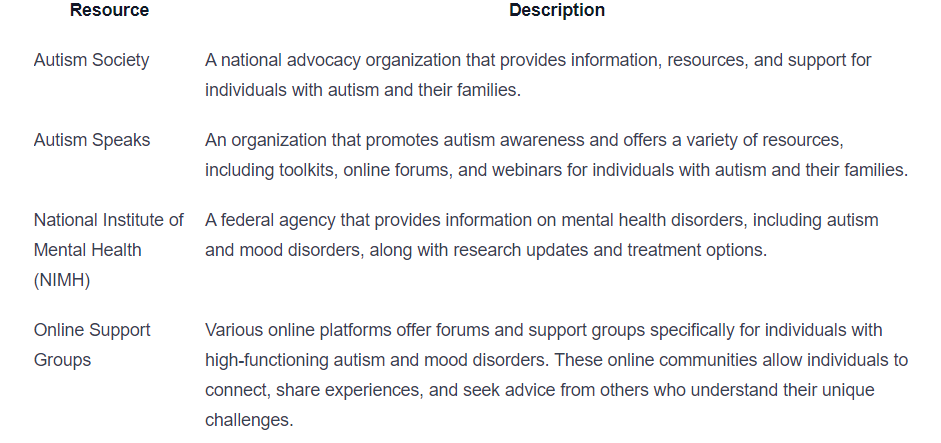Mood Disorders in High-Functioning Autism
Uncover the link between mood disorders and high-functioning autism. Explore diagnosis, treatment, and support for those affected.

Understanding High-Functioning Autism and Mood Disorders
In the realm of autism spectrum disorders (ASD), high-functioning autism (HFA) represents a unique subset. Here, we will delve into what high-functioning autism entails and explore the connection between HFA and mood disorders.

What is High-Functioning Autism?
High-functioning autism is a term used to describe individuals on the autism spectrum who possess average or above-average intelligence and exhibit relatively good verbal and cognitive abilities. While there is no official diagnosis of high-functioning autism in the Diagnostic and Statistical Manual of Mental Disorders (DSM-5), it is often used to differentiate individuals with ASD who have stronger language and intellectual skills.
People with high-functioning autism may exhibit challenges with social interaction, communication, and sensory processing. However, they may also demonstrate exceptional skills or interests in specific areas, such as mathematics, music, or technology.
Exploring Mood Disorders in Autism
Mood disorders are psychiatric conditions characterized by significant changes in mood, affecting an individual's emotional state and overall well-being. Research has shown that individuals with high-functioning autism are more susceptible to mood disorders compared to the general population.
Common mood disorders observed in individuals with high-functioning autism include:

It is important to note that diagnosing mood disorders in individuals with high-functioning autism can be challenging due to overlapping symptoms and difficulties in self-reporting. Additionally, the expression of mood disorders in autism may manifest differently than in individuals without autism, further complicating the diagnostic process.
Understanding the connection between high-functioning autism and mood disorders is crucial in providing appropriate support and interventions. By recognizing the increased vulnerability to mood disorders in individuals with high-functioning autism, healthcare professionals and caregivers can help facilitate early identification, assessment, and tailored treatment approaches.
In the following sections, we will explore the identification of mood disorders in high-functioning autism, the contributing factors that may influence their development, and the impact of these disorders on daily functioning.
Identifying Mood Disorders in High-Functioning Autism
When it comes to high-functioning autism, individuals may also experience mood disorders, which can significantly impact their emotional well-being and overall quality of life. Identifying these mood disorders in individuals with high-functioning autism can be both important and challenging. In this section, we will explore common mood disorders associated with high-functioning autism and the diagnostic challenges that may arise.
Common Mood Disorders
Individuals with high-functioning autism may experience various mood disorders that affect their emotional state. Some of the common mood disorders observed in this population include:

It's important to note that not all individuals with high-functioning autism will experience mood disorders, but the prevalence of these conditions is higher in this population compared to the general population.
Diagnostic Challenges
Diagnosing mood disorders in individuals with high-functioning autism can be challenging due to overlapping symptoms and the complexity of the presentation. Some diagnostic challenges include:
- Atypical Presentation: Mood disorders in individuals with high-functioning autism may manifest differently compared to those without autism. The presence of autism-related social and communication difficulties can mask or modify the expression of mood disorder symptoms.
- Limited Self-Report: Communication challenges and difficulty expressing emotions verbally can make it challenging for individuals with high-functioning autism to accurately describe their feelings and experiences.
- Comorbidity: Mood disorders often coexist with other conditions commonly seen in individuals with high-functioning autism, such as attention-deficit/hyperactivity disorder (ADHD) and sensory processing difficulties. Untangling the symptoms and determining the primary diagnosis can be complex.
- Assessment Tools: Standardized assessment tools for mood disorders may not capture the unique features and expressions seen in individuals with high-functioning autism. Adapted assessment tools specifically designed for this population may be necessary for accurate diagnosis.
To overcome these diagnostic challenges, it is crucial for healthcare professionals to have a comprehensive understanding of high-functioning autism and the complexities associated with mood disorders within this population. Collaboration between professionals from different disciplines, such as psychiatrists, psychologists, and autism specialists, can help ensure accurate diagnosis and appropriate treatment interventions.
Contributing Factors
When examining the connection between high-functioning autism and mood disorders, it's important to consider the various factors that contribute to the development and manifestation of these conditions. Two significant factors that play a role in this relationship are neurological connections and environmental triggers.
Neurological Connections
Neurologically, individuals with high-functioning autism experience unique patterns of brain connectivity that can influence their emotional well-being. Research suggests that alterations in neural circuitry and neurotransmitter imbalances may contribute to the development of mood disorders in individuals with high-functioning autism.
These neurological connections affect the regulation of emotions, leading to difficulties in managing and expressing feelings. The atypical wiring of the brain in individuals with high-functioning autism may result in heightened sensitivity to emotional stimuli, leading to mood dysregulation and an increased vulnerability to mood disorders such as depression and anxiety.
Environmental Triggers
Environmental factors also play a significant role in the development and exacerbation of mood disorders in individuals with high-functioning autism. Certain environmental triggers can impact emotional well-being and contribute to the manifestation of mood disorders.
Some common environmental triggers include:
- Sensory Overload: Individuals with high-functioning autism often experience sensory sensitivities and can become overwhelmed by sensory stimuli. This sensory overload can lead to increased stress levels and may contribute to the development of mood disorders.
- Social Challenges: Difficulties in social interactions and the challenges of navigating social expectations can be emotionally taxing for individuals with high-functioning autism. Feelings of social isolation, rejection, and misunderstanding can contribute to mood disturbances.
- Transitions and Changes: Routine disruptions, unexpected changes, and transitions can be particularly challenging for individuals with high-functioning autism. These disruptions can trigger anxiety and mood fluctuations.
- Bullying and Stigma: Individuals with high-functioning autism may face bullying or encounter stigma due to their differences. These negative experiences can significantly impact their emotional well-being and contribute to the development of mood disorders.
Understanding these contributing factors is crucial in developing effective strategies for managing mood disorders in individuals with high-functioning autism. By addressing both the neurological connections and environmental triggers, it is possible to provide comprehensive support and interventions that promote better emotional well-being and overall quality of life.
Impact on Daily Functioning
Individuals with high-functioning autism who also experience mood disorders may face challenges in various aspects of their daily functioning. These challenges can have an impact on their social interactions as well as their academic and occupational performance.
Social Interactions
Social interactions can be particularly challenging for individuals with high-functioning autism and mood disorders. They may struggle with understanding social cues, interpreting nonverbal communication, and maintaining appropriate social relationships. This can lead to difficulties in forming and maintaining friendships, feeling socially isolated, and experiencing higher levels of anxiety in social situations.
To better understand the impact on social interactions, let's consider the following statistics:

These statistics highlight the specific challenges that individuals with high-functioning autism and mood disorders may face in social interactions.
Academic and Occupational Performance
The impact of mood disorders in high-functioning autism can also extend to academic and occupational settings. Individuals may experience difficulties with focus, attention, and executive functioning skills, which can affect their ability to perform at their full potential.
In academic settings, individuals may struggle with staying organized, completing assignments, and managing their time effectively. They may also have difficulty coping with changes in routine or transitions between tasks. These challenges can lead to academic underachievement, increased stress, and a negative impact on their overall educational experience.
In occupational settings, individuals may face similar challenges related to focus and executive functioning. They may find it difficult to manage multiple tasks, meet deadlines, or navigate workplace social dynamics. These difficulties can impact job performance, job satisfaction, and career advancement opportunities.
It's important to recognize and address these challenges to support individuals with high-functioning autism and mood disorders in achieving academic and occupational success.
Understanding the impact on social interactions, academic performance, and occupational functioning can help guide interventions and support strategies to enhance the overall well-being and quality of life for individuals with high-functioning autism and mood disorders.
Treatment Approaches
When it comes to managing mood disorders in individuals with high-functioning autism, there are various treatment approaches available. These approaches aim to alleviate symptoms, improve overall well-being, and enhance daily functioning. Two common treatment options for mood disorders in high-functioning autism are behavioral therapies and medication.
Behavioral Therapies
Behavioral therapies play a crucial role in addressing mood disorders in individuals with high-functioning autism. These therapies focus on modifying behaviors and teaching individuals coping strategies to manage their emotions effectively. Some commonly used behavioral therapies include:
- Cognitive-Behavioral Therapy (CBT): CBT helps individuals identify and change negative thought patterns and behaviors that contribute to mood disorders. It aims to improve problem-solving skills, enhance emotional regulation, and promote positive coping mechanisms.
- Social Skills Training: This type of therapy focuses on improving social interactions and communication skills. It helps individuals with high-functioning autism develop and maintain meaningful relationships, which can have a positive impact on their mood and overall well-being.
- Applied Behavior Analysis (ABA): ABA is a comprehensive therapy that addresses various aspects of behavior and development. It can help individuals with high-functioning autism develop adaptive skills, reduce challenging behaviors, and improve their emotional well-being.
- Mindfulness-Based Therapies: These therapies, such as mindfulness-based stress reduction (MBSR) and mindfulness-based cognitive therapy (MBCT), incorporate mindfulness techniques to promote self-awareness, reduce stress, and improve emotional regulation.
Behavioral therapies are often tailored to meet the specific needs of individuals with high-functioning autism and mood disorders. They can be delivered in individual or group settings, depending on the preferences and requirements of the individual.
Medication Options
In some cases, medication may be recommended as part of the treatment plan for mood disorders in high-functioning autism. Medications can help manage symptoms and improve overall functioning. The specific medication prescribed will depend on the individual's symptoms, medical history, and the judgment of their healthcare provider.
Here are some commonly prescribed medications for mood disorders in high-functioning autism:

It's important to note that medication should always be prescribed and monitored by a qualified healthcare professional who specializes in autism and psychiatric disorders. Regular follow-up appointments are necessary to evaluate the effectiveness and potential side effects of the medication.
Combining behavioral therapies and medication can often yield the best outcomes in managing mood disorders in individuals with high-functioning autism. The treatment approach should be individualized, taking into account the specific needs and preferences of the individual. Regular communication and collaboration between healthcare providers, therapists, and caregivers are essential for a comprehensive and effective treatment plan.
Support and Resources
Individuals with high-functioning autism who experience mood disorders often benefit from a strong support system and access to appropriate resources. These can play a crucial role in their overall well-being and help them navigate the challenges associated with their condition.
Importance of Support Systems
Having a supportive network of family, friends, and professionals is essential for individuals with high-functioning autism and mood disorders. These support systems can provide emotional support, practical assistance, and guidance throughout their journey. Supportive individuals within the network can offer understanding, empathy, and help in managing daily stressors.
Additionally, support groups specifically tailored for individuals with high-functioning autism and mood disorders can be invaluable. These groups provide a safe space for individuals to share their experiences, learn from one another, and offer mutual support. Connecting with others who face similar challenges can provide comfort and a sense of belonging.
Community and Online Resources
In addition to personal support systems, there are numerous community and online resources available for individuals with high-functioning autism and mood disorders. These resources offer information, guidance, and access to additional support. Here are some examples:

These resources can provide valuable information, educational materials, and access to professional guidance. It's essential to evaluate the credibility and reliability of online resources and consult with healthcare professionals when seeking guidance or treatment options.
By utilizing support systems and accessing appropriate resources, individuals with high-functioning autism and mood disorders can enhance their understanding of their condition, find comfort in shared experiences, and discover strategies to manage their moods more effectively.
Sources
https://www.ncbi.nlm.nih.gov/pmc/articles/PMC7375152/
https://pubmed.ncbi.nlm.nih.gov/31028592/
https://www.kennedykrieger.org/stories/interactive-autism-network-ian/mood_instability_and_meltdown
Similar articles
We’re here to help you

Our team is here to assist you in this process. Contact us for any assistance.
it’s easy to apply
We Accept Most Insurances
Our in-network insurance partnerships make ABA therapy more accessible to families throughout our service areas.







Our Insurance Process
We'll request your insurance details to help us verify your plan's coverage for ABA therapy. Once we've received this information, we'll walk you through your benefits, including copayments, deductibles and out-of-pocket maximums, so you know what to expect in advance.
Our team will then handle the preauthorization and all the necessary paperwork.
.svg)





















.jpeg)


































.jpeg)




.jpeg)







.jpeg)











.jpeg)
















